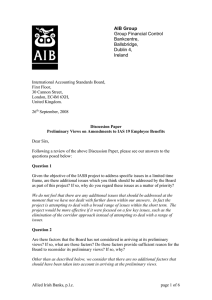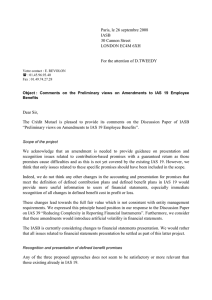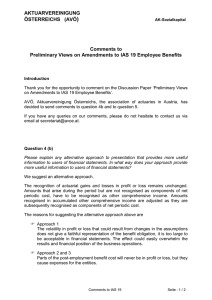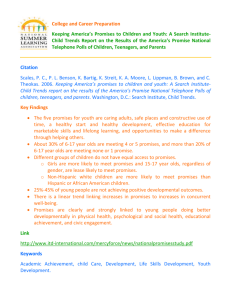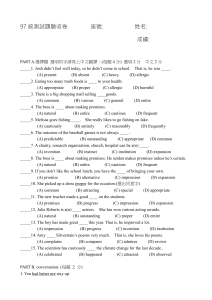Comment on DP IAS19.doc
advertisement
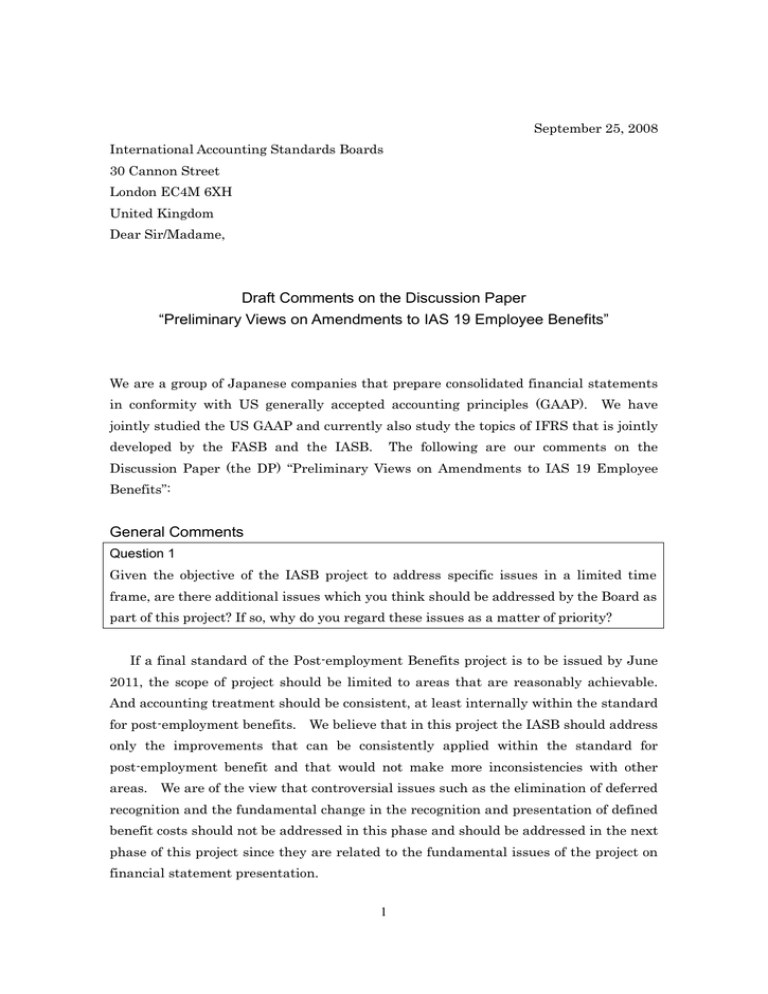
September 25, 2008 International Accounting Standards Boards 30 Cannon Street London EC4M 6XH United Kingdom Dear Sir/Madame, Draft Comments on the Discussion Paper “Preliminary Views on Amendments to IAS 19 Employee Benefits” We are a group of Japanese companies that prepare consolidated financial statements in conformity with US generally accepted accounting principles (GAAP). We have jointly studied the US GAAP and currently also study the topics of IFRS that is jointly developed by the FASB and the IASB. The following are our comments on the Discussion Paper (the DP) “Preliminary Views on Amendments to IAS 19 Employee Benefits”: General Comments Question 1 Given the objective of the IASB project to address specific issues in a limited time frame, are there additional issues which you think should be addressed by the Board as part of this project? If so, why do you regard these issues as a matter of priority? If a final standard of the Post-employment Benefits project is to be issued by June 2011, the scope of project should be limited to areas that are reasonably achievable. And accounting treatment should be consistent, at least internally within the standard for post-employment benefits. We believe that in this project the IASB should address only the improvements that can be consistently applied within the standard for post-employment benefit and that would not make more inconsistencies with other areas. We are of the view that controversial issues such as the elimination of deferred recognition and the fundamental change in the recognition and presentation of defined benefit costs should not be addressed in this phase and should be addressed in the next phase of this project since they are related to the fundamental issues of the project on financial statement presentation. 1 The DP proposes that post-employment benefit promises, which are currently classified as defined contribution plans or defined benefit plans, should be classified as contribution-based promises or defined benefit promises. Cash balance plans, which are currently categorized as defined benefit plans, should be categorized as contribution-based promises. The DP also proposes that an entity should measure its liability for a contribution-based promise at fair value. However, the proposed classification between contribution-based promise and defined benefit promise is far more complex and ambiguous than that between defined contribution plan and defined benefit plan in the existing IAS 19 which depends on whether an entity is obliged to pay further benefits in the future. We also are of the view that the fair value measurement method for contribution-based promises proposed in the DP would involve far more problems, including the issue of the treatment of credit risk as described later. It would be difficult to resolve them by June 2011. Therefore, we believe that the IASB should withhold the discussions about the proposal of fair value measurement for contribution-based promises. Recognition and presentation of defined benefit promises (Chapter 2 & 3) Question 2 Are there factors that the Board has not considered in arriving at its preliminary views? If so, what are those factors? Do those factors provide sufficient reason for the Board to reconsider its preliminary views? If so, why? The DP proposes that entities should recognise the funded status of a defined benefit promise (that is, the value of plan assets less the value of defined benefit obligation) as an asset or a liability in the statement of financial position and concurrently recognise changes in that funded status in its statement of comprehensive income immediately, without deferred recognition. We are of the view that the scope of this project should be limited to areas that can be achieved by June 2011 and thus controversial issues such as the elimination of deferred recognition should be addressed not in this phase (Phase I) but in the next phase of the project. The DP notes the main criticism of the deferred recognition model in the existing IAS 19, including the problem that an employer with a defined benefit plan is not required to recognise the changes in plan assets and benefit obligations as the cost of providing post-employment benefit promises when those changes take place and the problem that an entity may recognise an asset when a plan is in deficit (or vice versa). 2 However, for the purpose of resolving those problems, recognition of the funded status of a defined benefit promise in the statement of financial position, similar to the accounting treatment of SFAS No.158 “Employers’ Accounting for Defined Benefit Pensions and Other Postretirement Plans” of the FASB, would be sufficient and there is no need to fundamentally change the basic approach in measurement of net defined benefit cost under the existing IAS 19. The DP proposes that entities should recognise unvested past service cost in the period of a plan amendment. We are of the view that immediate recognition of unvested past service cost as a liability in the statement of financial position would not necessarily lead to its immediate recognition in profit or loss. We also consider that attributing the unvested past service cost to employee’s future service until vesting date by using recycling would maintain consistency with the accounting treatment in IFRS 2 “Share–based Payment”. Question 3 (a) Which approach to the presentation of changes in defined benefit costs provides the most useful information to users of financial statements? Why? (b) In assessing the usefulness of information to users, what importance do you attach to each of the following factors, and why: (i) presentation of some components of defined benefit cost in other comprehensive income; and (ii) disaggregation of information about fair value? (c) What would be the difficulties in applying each of the presentation approaches? Question 4 (a) How could the Board improve the approaches discussed in this paper to provide more useful information to users of financial statements? (b) Please explain any alternative approach to presentation that provides more useful information to users of financial statements. In what way does your approach provide more useful information to users of financial statements? We support none of the alternative approaches proposed by the DP. We do not agree with Approach 1 because actuarial gain or loss due to changes of fair value or discount rates would be presented included in profit or loss and this would inappropriately combine information with different predictable implications. We do not agree with Approach 2 because we do not support that it would include in other comprehensive 3 income an item that is not a remeasurement change (such as interest cost). We do not agree with Approach 3 because it is not practical to require entities to disaggregate interest income on plan assets from other changes in fair value of plan assets although this approach would be based on the view that items presented in other comprehensive income should be price or value changes. In Approach 2 and Approach 3, some part of changes in plan assets and defined benefit obligation permanently is omitted from profit or loss since they are recognized in other comprehensive income and never recycled to profit or loss (and earnings per share), which is considered as a total performance indicator. Under this situation, clean surplus relationship between profit or loss and owners’ equity, as prescribed in the accounting standards in major countries such as the United States and Japan, would not be maintained. We are of the view that the basic approach in measurement of net defined benefit cost under the existing IAS 19 should not be changed and should be continued in this phase of the project. In this view, the actuarial gains or losses and past service costs that arise during the period but are not recognised as components of net defined benefit cost pursuant to IAS 19 should be recognised as a component of other comprehensive income and included in accumulated other comprehensive income of the statement of financial position. Amounts recognised in accumulated other comprehensive income should be adjusted (recycled) as they are subsequently recognised as components of net defined benefit costs pursuant to IAS 19, which would be the similar accounting treatment of SFAS No.158 of FASB. Definition of contribution-based promises (Chapter 5) Question 5 Do you agree that the Board has identified the appropriate promises to be addressed in the scope of this project? If not, which promises should be included or excluded from the scope of the project, and why? Question 6 Would many promises be reclassified from defined benefit to contribution-based under the Board’s proposals? What are the practical difficulties, if any, facing entities affected by these proposals? Large differences exist in accounting treatment between contribution-based promises and defined benefit promises. The definition of contribution-based promises is important because contribution-based promises are defined first and the rest is defined as defined benefit promises. However, the definition proposed in the DP is not 4 strict enough and therefore may not fully provide a clear distinction between defined benefit promises and contribution-based promises. For example, although the DP propose to exclude promises with salary risk from the definition of contribution-based promises, what “salary” means depends on systems or practices in each country. Therefore, it is appropriate to withhold the discussions in phase I of this project based on such ambiguous and unstable definitions. As described in the DP, some promises for which the measurement requirements of IAS 19 are not particularly difficult to apply, such as fixed return promises, are included in the scope of contribution-based promises. In Japan, by regulations, a promised return in cash balance plans is generally limited to a return linked to a yield of government bonds or a fixed return. Those plans would be also included in the scope of contribution-based promises, although the measurement requirements of IAS 19 are not difficult to apply. The scope of contribution-based promises should be reconsidered so as to exclude the promises as discussed above for which applying the measurement requirements of IAS 19 would not be difficult. Question 7 Do the proposals achieve that goal? If not, why not? Defined contribution plans in Japan require entities to pay contributions every month and thus the period for discount would be short. Accordingly, the proposals of the DP would not invite significant changes in the accounting for plans that are defined contribution plans under IAS 19. However, we think that the disclosure of defined contribution plans may be affected in some cases and additional disclosure beyond IAS 19 may be required under the DP. We consider that this question again raises concern about the appropriateness of the scope of contribution-based promises. According to the DP, the IASB does not intend significant changes in the accounting for most of defined contribution plans under IAS 19, while the DP proposes that those plans should be classified as contribution-based promises that shall be measured at fair value. We are of the view that defined contribution plans should be excluded from the scope of contribution-based promises. Measurement of contribution-based promises (Chapter 7) Question 9 (a) Are there alternative measurement approaches that better meet the measurement 5 objectives described in this paper? Please describe the approaches and explain how they better meet the measurement objectives. (b) To what extent should the effect of risk be included as a component of the measurement approach at this stage of the Board’s post-employment benefit promises project? How should this be done? The DP proposes that an entity should measure its liability for a contribution-based promise at fair value. However, we think that such measurement would involve various problems as described below and thus it would be very difficult to apply in practice. Also from this viewpoint, we believe that the discussions based on the proposed approach to contribution-based promises should be withheld. The DP proposes that it is necessary to reflect credit risk in measuring contribution-based promise at fair value. However, it is not feasible in practice to obtain necessary information for reflecting credit risk. In Japan, in case of bankruptcy, employees’ claims on retirement benefits are given higher priority than other creditors’ claims when the entity introduces an unfunded plan under which it is obliged to pay the benefits to employees directly. In such situations, the credit risk to be reflected in the measurement of the benefit obligation would be different from the overall credit risk of the entity and the information about these situations would be very difficult to obtain. Measurement of benefits after the accumulation phase (Chapter 8) Question 10 (a) Do you agree that the liability for benefits in the payout and deferment phases should be measured in the same way as they are in the accumulation phase? If not, why? (b) What are the practical difficulties, if any, of measuring the liability for a contribution-based promise during the payout phase at fair value assuming the terms of the benefit promise do not change? The measurement approach proposed in the DP would invite a serious problem that the liability for contribution-based promise at retirement is measured differently from the liability for defined benefit promise, even though these promises are economically the same. Therefore, we think that the proposed approach obviously has problems from the viewpoint of faithful representation and creates an internal inconsistency within 6 post-employment benefit accounting. Disaggregation, presentation and disclosure of contribution-based promises (Chapter 9) Question 11 (a) What level of disaggregation of information about changes in the liability for contribution-based promises is useful to users of financial statements? Why? (b) Do you agree that it is difficult to disaggregate changes in the contribution-based promise liability into components similar to those required for defined benefit promises? If not, why not? The DP proposes that the changes in the liability for contribution-based promise should be disaggregated only into service cost and other fair value changes because identifying interest cost from them would add complexity that outweighs the benefit of the additional information. However, as for certain promises, such as those with a fixed return or a return linked to a yield of government bonds, the measurement requirements of IAS 19 are not particularly difficult to apply, because it is not difficult to indentify interest cost. From this viewpoint, the scope of contribution-based promises should be reconsidered. Question 12 Should changes in the liability for contribution-based promises: (a) be presented in profit or loss, along with all changes in the value of any plan assets; or (b) mirror the presentation of changes in the liability for defined benefit promises (see Chapter 3)? Why? We are seriously concerned about issues related to measurement of liabilities at fair value, noted in the Discussion Paper “Reducing Complexity in Reporting Financial Instruments”, in particular, the issue about a decrease of a liability and thus recognition of gains resulted from an increase of credit risk of the reporting entity. Accordingly, we are of the view that changes in the credit risk should not be included in measurement of contribution-based promises and the changes in the value of liabilities of contribution-based promises should not be presented in profit or loss. 7 We hope that our comments will contribute to the discussion of this project. Sincerely yours, A Group of Japanese Companies: ITOCHU Corporation CANON INC. Hitachi, Ltd. HONDA MOTOR CO., LTD. KUBOTA Corporation KYOCERA Corporation Marubeni Corporation Matsushita Electric Industrial Co., Ltd. (Panasonic Corporation) Mitsui & Co., Ltd. Murata Manufacturing Co., Ltd. NIDEC CORPORATION RICOH COMPANY, LTD. Sony Corporation Sumitomo Corporation TDK Corporation Wacoal Holdings Corp. 8
